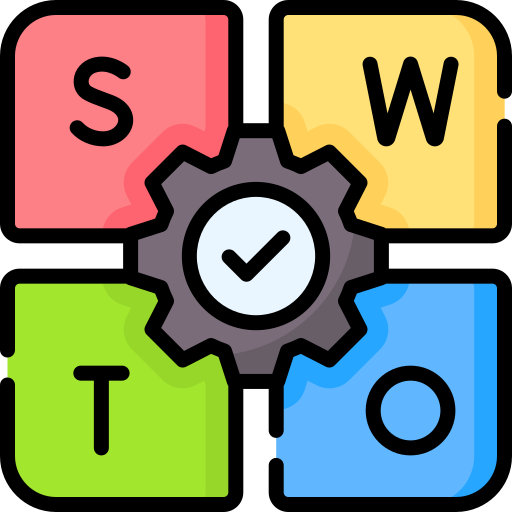Ever wondered how to transform classroomuncertainty into confidentaction plans?

SWOT analysis is a secret toolbox for class projects and lessons. It's a strategic approach that shines a light on strengths, weaknesses, opportunities, and threats in education.
This method isn't about adding complexity — it's about simplifying decision-making, ensuring every class project and lesson becomes an opportunity for incredible learning and discovery.

Armed with just 3 key strategies, you'll see how SWOT can elevate your teaching from standard to spectacular, turning challenges into chances for success. It's about making your class activities way cooler than the usual.
Redefine classroom dynamics, making every lesson a journey of exploration and every obstacle a step towards brilliance.

1. Analyze Student Performance
SWOT analysis is a tool that comes from the business world. In the classroom, you can use SWOT to identify:
Students' academic strengths & weaknesses
Opportunities that will help them grow
Recognizing potential threats to their academic success

Consider a student who shines in math but finds public speaking challenging. This scenario reveals a strength in logical thinking and a weakness in verbal communication.
Have a look at a SWOT analysis example for this student:

Strengths
Excelling in math

Weaknesses
Difficulty with public speaking

Opportunities
Joining a debate club to improve speaking skills

Threats
Poor time management impacting preparation
By mapping these elements in a SWOT matrix like the one above, educators can craft targeted strategies to support each student's growth, turning potential weaknesses into opportunities for development.
2. Enhance Lesson Plans
Applying SWOT analysis to lesson planning can significantly boost the effectiveness of curriculum design, especially for hands-on activities like science experiments.

Here is a SWOT analysis example for a volcano eruption experiment lesson plan:

Strengths
Simple setup
High student interest

Weaknesses
Instructor's inexperience with the experiment

Opportunities
Enhancing teamwork
Understanding of chemical reactions

Threats
Limited materials & time constraints
Varying student engagement levels
The straightforward nature of the experiment (strength) is balanced against the teacher's lack of familiarity with it (weakness).
The opportunity lies in the experiment's ability to foster collaboration and scientific curiosity, while the threats include logistical challenges like insufficient materials and the need to keep all students engaged within a tight timeframe.

Addressing these elements, a teacher might:
Practice the experiment beforehand to mitigate inexperience.
Source alternative materials or seek funding for supplies.
Design the session to maximize hands-on time, keeping engagement high.

By strategically planning around the SWOT analysis, educators can transform potential setbacks into powerful learning opportunities, ensuring the lesson is as effective and engaging as possible.
3. Improve Group Projects
ntegrating SWOT analysis into student projects requires a thoughtful approach to ensure students grasp the concept and apply it effectively.
This structured method allows teachers to scaffold SWOT analysis for their students:

Introduce SWOT basics:
Explain SWOT (strengths, weaknesses, opportunities, threats) using everyday examples to clarify each element.
Demonstrate with an example:
Conduct a SWOT analysis on a topic relatable to students, actively involving them in identifying each SWOT component.
Group practice:
Organize students into small teams for a practice SWOT analysis on a simple project or topic, providing support as needed.

Solo application:
Assign an individual task where students apply SWOT to a personal goal, offering structured worksheets for assistance.
Class sharing and reflection:
Let students present their SWOT analyses and discuss their insights, emphasizing the applicability of SWOT in different scenarios.
Reinforce in future projects:
Continually incorporate SWOT into class projects, increasing the complexity as students grow more adept.
Quiz Time!

Jamie has used SWOT analysis to understand her classroom dynamics better. Here is a SWOT analysis example to describe what she has observed:

Strengths
Creativity
Teamwork

Weaknesses
Varying levels of participation
Difficulty with time management

Threats
Limited access to technology
Potential disruptions in the classroom environment

Considering these factors, what opportunity should Jamie pursue to enhance classroom dynamics and address these weaknesses and threats?
A. Introduce more traditional lectures to ensure uniform teaching delivery.
B. Implement collaborative projects that leverage students' creativity and teamwork, while encouraging increased participation and time management skills.
C. Wait for students to naturally overcome their weaknesses without intervention.
D. Increase the use of technology in the classroom, regardless of access limitations.
Quiz
Which opportunity should Jamie pursue?
Take Action

Integrating SWOT analysis in teaching crafts a tailored and impactful learning space for your students!
Let SWOT guide you like a captain in education's uncharted waters, enhancing your navigation through teaching's challenges and opportunities.

Your feedback matters to us.
This Byte helped me better understand the topic.
